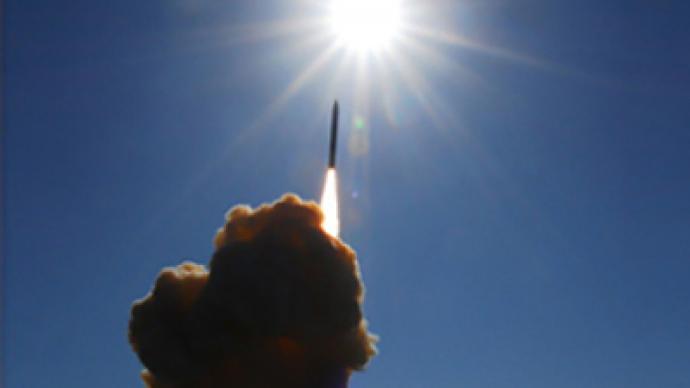Behind the shine of Obama’s new nuclear doctrine

Washington is set to announce a new military strategy that reduces the conditions in which the US would resort to the use of nuclear weapons, but is the plan more hype than glory?
On the surface, recent comments by US President Barack Obama over his revamped nuclear policy look promising. After all, few could argue against a world that is free of the nuclear Sword of Damocles that continues to hang over everybody’s head. But already analysts are wondering if the pledges are little more than a spoonful of sugar-coated poison by America’s gifted orator.
In the Nuclear Posture Review (NPR), which is scheduled for release on Tuesday, the United States commits itself “to reduce the role of nuclear weapons in deterring non-nuclear attacks.”
The new enemy-friendly approach applies to “states that are party to the Nuclear Non-Proliferation Treaty and in compliance with their nuclear non-proliferation obligations.”
So far so good for Russia, a signatory to the NPT.
Next, the NPR declares that the US will stop developing nuclear technology, which, considering America's incessant love affair with all things shiny, fast and destructive, requires the greatest leap of faith to believe.
“The United States will not develop new nuclear warheads,” an early-release version of the text reads. “Life Extension Programs will use only nuclear components based on previously tested designs, and will not support new military missions or provide for new military capabilities."
In order to implement his nuclear strategy, Obama told The New York Times in an interview, special emphasis will be placed on conventional weapons to “make sure that the American people are safe and secure.”
“We are going to make sure that we can continue to move towards less emphasis on nuclear weapons… to make sure that our conventional weapons capability is an effective deterrent in all but the most extreme circumstances,” Obama said.
The New York Times said the American president described his new policy as "part of a broader effort to edge the world toward making nuclear weapons obsolete, and to create incentives for countries to give up any nuclear ambitions."
Is Obama dealing a nuclear bluff?
In short, the new nuclear doctrine is based on three columns: 1. the United States declares that it will reduce its dependency on nuclear weapons as a means for retaliating against some hypothetical enemy; 2. the United States will stop the research and development of “nuclear components;” and 3. START, the arms-control document that the United States will sign into force with Russia on Thursday.
On this point, it is worth recalling that according to Russia’s Military Doctrine, the use of nuclear weapons is permissible when "the very existence of [Russia] is under threat."
According to Nikolai Sokov, a research analyst with the Center for Non-proliferation Studies, Russia aims to keep open the possibility of using nuclear weapons in the event of an attack of a conventional nature.
“The new Doctrine reserves the right to use nuclear weapons not only in response to a nuclear attack or an attack with other WMD (a slight revision of the negative assurances that has become common among nuclear weapons states since 2000),” Sokov writes, “but also in response to a conventional attack. In other words, it keeps the first-use plank.”
This slightly revised strategy has caused consternation in some circles in Washington.
“There are aspects to their [Russia’s] nuclear doctrine, their military activities that we find very troubling,” said Michèle Flournoy, Defense Department undersecretary for policy in an interview with the Financial Times.
She said that, while Obama had stressed “the importance of reducing the role of nuclear weapons… if you read recent Russian military doctrine they are going in the other direction, they are actually increasing their reliance on nuclear weapons, the role in nuclear weapons in their strategy.”
However, Sokov argues that Russia’s overall dependency on nuclear weapons has actually decreased, while there has been renewed interest in high-tech military assets.
“Overall, [Russia’s] 2010 Doctrine devotes less attention to the nuclear component of Armed Forces than the previous one,” Sokov writes. “This is clear at the most superficial level: there are fewer paragraphs about the use of nuclear weapons and nuclear posture. In general, the doctrine places considerably more emphasis on conventional forces and in particular on high-precision assets, communications, command and control systems, and other elements in which Russia has been traditionally behind other major military powers.”
The question now, with the US and Russia on the threshold of signing into force the new START treaty, is how long will both sides will be able to maintain such military posturing. In other words, which side will blink first?
The fact is, it remains almost impossible to say how any country will respond to any future threats, either real or imagined, to its national security. For example, the United States declared war on Iraq in March 2003 without the slightest proof that Iraq was involved in the attacks of 9/11, or harboring weapons of mass destruction (as it turned out, it was guilty of neither charge). Its Preemptive" military operation tunred out to be mere presumption. And let's not forget that the next American president – especially if he or she turns out to be another Neocon – may severely modify Obama’s new nuclear plan.
Meanwhile, it is important to keep in mind that the US still has an estimated 200-300 tactical nuclear weapons stationed in Western Europe, which seems to cut against the grain of Obama’s dream of a “nuclear-free world.”
The Strategic Arms Reduction Treaty, or START, does not apply to America’s European nuclear arsenal, which is categorized as "non-strategic" because they comprise short-range munitions designed for fighter jets based in Europe, including NATO members.
Ivo Daalder, the US ambassador to NATO, said in February that the NPR "will not make any decisions that preclude any option with respect to nuclear weapons and NATO."
In other words, when it comes to US weapons – both defensive and offensive – on the European continent, all the options are on the table.
It is no wonder, then, that Russia is already harboring reservations over the soon-to-be-renewed START (which restricts both Russia and the US to 1,550 warheads, about 30 per cent fewer than currently allowed), saying it reserves the right to back out of the nuclear arms deal at any time.
"The Russian Federation will have the right to withdraw from the (new) treaty if the quantitative and qualitative growth of the potential of the US strategic anti-missile defense starts exerting substantial influence on the efficiency of the Russian strategic nuclear forces,” Sergey Lavrov, Russian Foreign Minister, told reporters on Tuesday. “It goes without saying that we ourselves will determine the degree of this influence."
The Russian foreign minister then alluded to America’s go-it-alone strategy in Europe, particularly over its missile defense plans for Romania, which is raising a lot of eyebrows in Russia.
"The plans the United States is now expanding on a unilateral basis (on anti-missile deployments in Europe) have several stages, and the first stages involve regional systems which do not inflict damage to strategic stability and do not create risks for the Russian strategic forces."
Lavrov concluded by making a direct connection between Washington’s declared aspiration of a nuclear-free world, and its provocative decision to build a sophisticated missile defense system on Russia’s doorstep.
"In order to move towards a nuclear-free world, it is necessary to resolve the issue of strategic offensive weapons, and in general, non-nuclear strategic weapons, which the United States, specifically, is now developing,” Lavrov said.
“It is a serious subject which determines overall global strategic stability," Lavrov concluded.
Indeed, it remains to be seen how long both sides will stick to their commitments in an atmosphere of increasing mistrust.













